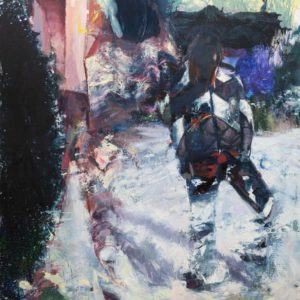One to Watch
 Gagyi Botond: Reality in the Age of Social Media
Gagyi Botond: Reality in the Age of Social Media
Gagyi Botond’s gestural, fragmentary paintings explore the obfuscation of reality in the digital age. Beginning with photos of ordinary people and places found on social media, Gagyi manipulates his found material into new images, which then form the basis of his paintings. The process—akin to social media’s reconfiguration of reality—results in figures captured in fluctuating spaces, floating between what we see and what is real.
Gagyi earned a Master’s degree in Painting from the University of Art and Design in Cluj-Napoca, Romania, where he is currently working toward his PhD. He has participated in solo and group exhibitions throughout Romania and Europe.
Tell us about who you are and what you do. What’s your background?
My name is Gagyi Botond, and I am a painter of Transylvanian origin. I was born in Târgu-Mureș, Romania, but I currently live and work in Cluj-Napoca, Romania. At the moment, I am continuing my fine arts studies as a PhD student at the University of Art and Design of Cluj-Napoca, where I also earned my bachelor’s and master’s degrees. I have participated in several group exhibitions both in my country as well as abroad, and, as a result of this exposure, the list of my solo exhibitions has grown. As a winner of the 2017 StartPoint Prize for European art graduates, I had the chance to exhibit my paintings at the Trade Fair Palace in the National Gallery in Prague.
What does your work aim to say? What are the major themes you pursue in your work?
My paintings are not about a false representation of reality, but rather the suggestion that reality is no longer real. It is important to keep in mind that while the illusionary worlds of the internet have their bases in reality—and seem inexhaustibly rich—they in fact represent a world lacking space and dimensions. In my Monument for Future series, for instance, I aim to problematize this particular process of abstraction. The oil paintings’ figures, which are taken out of their original context, refer exactly to these artificial, digital relationships and their abstract nature. The frequent loose gestures perhaps suggest the pulsing life’s illusion—we see that we are just witnesses of a simulacrum of life. This is the story that I try to compress into every one of my paintings: the excitement of life. The experience is born between the omissions, repainting, erasures and piling up of paint.
Can you walk us through your process for creating a work from beginning to end?
My painting process is set off by a micro story torn down to the level of everyday life, a story of an average person I happened upon on the internet. After manipulating a found digital image with various digital image-making procedures—processes that are simultaneously constructive and deconstructive—the found and transformed digital image becomes alienated from its original content. The new image springs into its own existence to be filled with new content, to become part of the emerging visual structure of the painting. The play between the painting and its inwrought bodies is an indispensable part of my process.
What series or artistic project are you working on next?
I’m planning to make a new series of paintings that is yet unnamed, but from a technical perspective I have a very clear idea about them. The paintings will be based on the same concepts that I have mentioned above, but the technical implementation would follow a totally different directive. Canvas will be replaced by large scale paper that has been primed in different ways, and oil and acrylic will be replaced by bitumen.
Who are your biggest influences and why?
It wouldn’t be hard to name artists whose visual worlds influence aspects of my paintings, but the truly hard thing is to ignore these influences and build a painting from the things found by me, and in this way challenge myself to keep evolving. Outside artistic influences last for a short period of time, and they don’t let me progress in my work—they don’t let me evolve or achieve original solutions. For me, progress in my painting practice is ensured by transforming material and making unusual pairings, or, for that matter, cutting up sketches based on photos taken by me or on photos that I stumbled upon.
Why art?
Because I consider art to be a creative practice filled with contradictions that entails questioning itself as a practice.
Love reading about all things art? You can have articles from Canvas, curated collections, and stories about emerging artists delivered straight to your inbox. Sign up for the Saatchi Art Newsletter.















